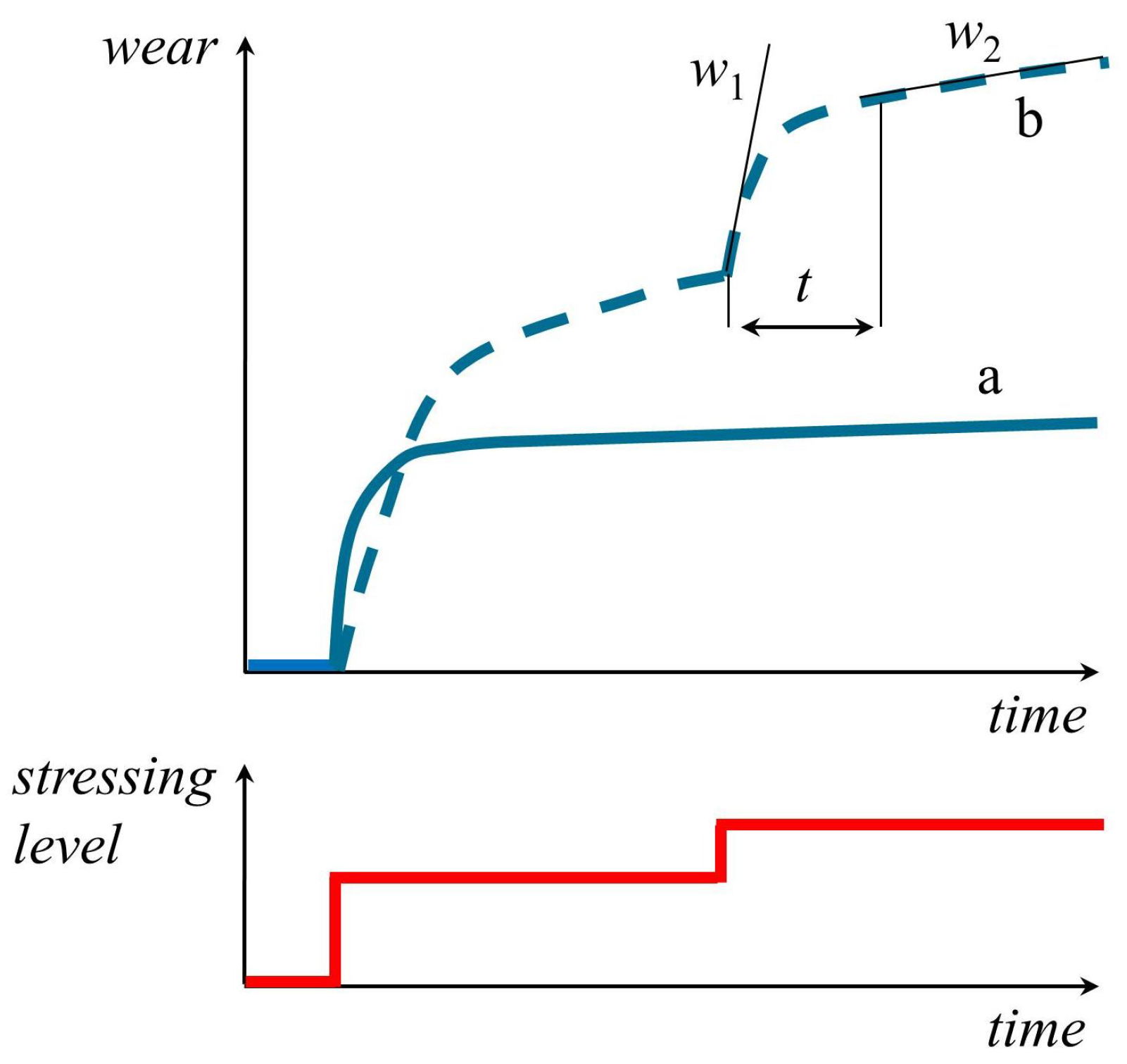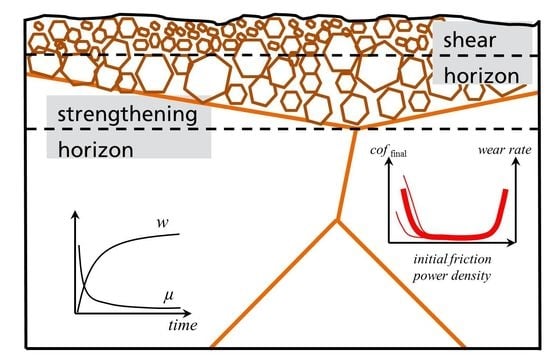The Running-in of Lubricated Metal-Metal Contacts—A Review on Ultra-Low Wear Systems
Abstract
:1. Introduction
2. Friction and Wear Behavior
2.1. General Friction and Wear Trends
2.2. The Energetic View on Friction and Wear
2.3. Sensitivity and Stability
2.4. Evaluation of Running-in Wear
- the wear rate immediately after a variation of the operating conditions towards higher loads ,
- the period of time t until a constant value of wear rate is reached,
- the wear rate upon reaching a stationary wear behavior .
3. Running-in Performance
3.1. Running-in Corridor
3.2. Structural and Chemical Evolution
4. Running-in Optimization
4.1. Parameter Fields
4.2. Pre-Conditioning
5. Testing
5.1. Continuous Wear Measurement
5.2. Analytics
6. Conclusions
- The running-in is the phase in the lifetime of a tribological system when the most important parameters such as friction coefficient, wear rate, stability and sensitivity become determined.
- Only adequate stressing conditions initiate this type of running-in. In most of the cases running-in can be achieved, when the initial stressing conditions are located inside an appropriate energetic corridor.
- The running-in generates a third body characterized by dissipative surface structures, nano-crystalline grain structure, the incorporation of foreign elements by plastic flow and mechanical intermixing. The third body is responsible for ultra-low wear and low friction.
- Running-in can be enforced by optimized parameter fields and by adequate sample finishing.
- The course of the running-in can be monitored by radionuclide technique and the properties of the third body can be evaluated by surface science methods.
Conflicts of Interest
References
- Rigney, D.A. Transfer, mixing and associated chemical and mechanical processes during the sliding of ductile materials. Wear 2000, 245, 1–9. [Google Scholar] [CrossRef]
- Scherge, M.; Shakhvorostov, D.; Poehlmann, K. Fundamental wear mechanism of metals. Wear 2003, 255, 395–400. [Google Scholar] [CrossRef]
- Dienwiebel, M.; Scherge, M. Fundamentals of Friction and Wear on the Nanoscale; Springer: Berlin, Germany, 2014. [Google Scholar]
- Bowden, F. A review of the friction of solids. Wear 1958, 1, 333–346. [Google Scholar] [CrossRef]
- Shakhvorostov, D.; Poehlmann, K.; Scherge, M. An energetic approach to friction, wear and temperature. Wear 2004, 257, 124–130. [Google Scholar] [CrossRef]
- Linsler, D.; Schroeckert, F.; Scherge, M. Influence of subsurface plastic deformation on the running-in behavior of a hypoeutectic AlSi alloy. Tribol. Int. 2016, 100, 224–230. [Google Scholar] [CrossRef]
- Scherge, M.; Poehlmann, K.; Gerve, A. Wear measurement using radionuclide-technique (RNT). Wear 2003, 254, 801–817. [Google Scholar] [CrossRef]
- Brink, A.; Lichtenberg, K.; Scherge, M. Influencing the tibological performance by different initial microstructures and adjusting stressing levels during the running-in. Wear 2016, 360-361, 114–120. [Google Scholar] [CrossRef]
- Linsler, D.; Schlarb, T.; Weingaertner, T.; Scherge, M. Influence of subsurface microstructure on the running-in of an AlSi alloy. Wear 2015, 332–333, 926–931. [Google Scholar] [CrossRef]
- Scherge, M.; Linsler, D.; Schlarb, T. The running-in corridor of lubricated metal–metal contacts. Wear 2015, 342–343, 60–64. [Google Scholar] [CrossRef]
- Antusch, S.; Dienwiebel, M.; Nold, E.; Albers, P.; Spicher, U.; Scherge, M. On the tribochemical action of engine soot. Wear 2010, 269, 1–12. [Google Scholar] [CrossRef]
- Scherge, M.; Boettcher, R.; Kuerten, D.; Linsler, D. Multi-Phase Friction and Wear Reduction by Copper Nanopartices. Lubricants 2016, 4, 36. [Google Scholar] [CrossRef]
- Popov, V.; Kroener, E. Theory of elastoplastic media with mesostructure. Theor. Appl. Fract. Mech. 2001, 37, 299–310. [Google Scholar] [CrossRef]
- Shakhvorostov, D.; Gleising, B.; Buescher, R.; Dudzinski, W.; Fischer, A.; Scherge, M. Microstructure of tribologically induced nanolayers produced at ultra-low wear rates. Wear 2007, 263, 1259–1265. [Google Scholar] [CrossRef]
- Linz, M.; Ripoll, M.R.; Gachot, C.; Pauly, C.; Franek, F.; Muecklich, F. On the competition between plastic deformation and material detachment in ferritic/pearlitic steel under boundary lubrication. Wear 2017, 376–377, 813–821. [Google Scholar] [CrossRef]
- Scherge, M.; Brink, A.; Linsler, D. Tribofilms Forming in Oil-Lubricated Contacts. Lubricants 2016, 4, 27. [Google Scholar] [CrossRef]
- Schiøz, J.; Di Tolla, d.F.; Jacobsen, K.W. Softening of nanocrystalline metals at very small grain size. Nature 1998, 391, 561. [Google Scholar] [CrossRef]
- Arzt, E. Size effects in materials due to microstructural and dimensional constraints: A comparative review. Acta Mater. 1998, 46, 5611–5626. [Google Scholar] [CrossRef]
- Gleiter, H. Materials with ultrafine microstructures: Retrospectives and perspectives. Nanostruct. Mater. 1992, 1, 1–19. [Google Scholar] [CrossRef]
- Chokshi, A.; Rosen, A.; Karch, J.; Gleiter, H. On the validity of the hall-petch relationship in nanocrystalline materials. Scr. Metall. 1989, 23, 1679–1683. [Google Scholar] [CrossRef]
- Shakhvorostov, D.; Poehlmann, K.; Scherge, M. Structure and mechanical properties of tribologically induced nanolayers. Wear 2006, 260, 433–437. [Google Scholar] [CrossRef]
- Kragelsky, I.V.; Dobychin, M.N.; Kombalov, V.S. Chapter 6—Friction on Impact. In Friction and Wear; Kragelsky, I.V., Dobychin, M.N., Kombalov, V.S., Eds.; Elsevier: Pergamon, Turkey, 1982; pp. 208–218. [Google Scholar]
- Godet, M. The third-body approach: A mechanical view of wear. Wear 1984, 100, 437–452. [Google Scholar] [CrossRef]
- Fischer, A.; Weiss, S.; Wimmer, M.A. The tribological difference between biomedical steels and CoCrMo-alloys. J. Mech. Behav. Biomed. Mater. 2012, 9, 50–62. [Google Scholar] [CrossRef] [PubMed] [Green Version]
- Quinn, T.; Rowson, D.; Sullivan, J. Application of the oxidational theory of mild wear to the sliding wear of low alloy steel. Wear 1980, 65, 1–20. [Google Scholar] [CrossRef]
- Blok, H. The flash temperature concept. Wear 1963, 6, 483–494. [Google Scholar] [CrossRef]
- Kuhlmann-Wilsdorf, D. Flash temperatures due to friction and Joule heat at asperity contacts. Wear 1985, 105, 187–198. [Google Scholar] [CrossRef]
- Volz, J. Erstellung Optimierter Einlaufprogramme von Dieselmotoren; Karlsruhe Institute of Technology: Karlsruhe, Germany, 1977. [Google Scholar]
- Berlet, P.; Dienwiebel, M.; Scherge, M. The effect of sample finishing on the tribology of metal/metal lubricated contacts. Wear 2010, 268, 1518–1523. [Google Scholar] [CrossRef]
- Scherge, M.; Martin, J.; Poehlmann, K. Characterization of wear debris of systems operated under low wear-rate conditions. Wear 2006, 260, 458–461. [Google Scholar] [CrossRef]
- Ditroi, F.; Takacs, S.; Tarkanyi, F.; Reichel, M.; Scherge, M.; Gerve, A. Thin layer activation of large areas for wear study. Wear 2006, 261, 1397–1400. [Google Scholar] [CrossRef]






© 2018 by the author. Licensee MDPI, Basel, Switzerland. This article is an open access article distributed under the terms and conditions of the Creative Commons Attribution (CC BY) license (http://creativecommons.org/licenses/by/4.0/).
Share and Cite
Scherge, M. The Running-in of Lubricated Metal-Metal Contacts—A Review on Ultra-Low Wear Systems. Lubricants 2018, 6, 54. https://doi.org/10.3390/lubricants6020054
Scherge M. The Running-in of Lubricated Metal-Metal Contacts—A Review on Ultra-Low Wear Systems. Lubricants. 2018; 6(2):54. https://doi.org/10.3390/lubricants6020054
Chicago/Turabian StyleScherge, Matthias. 2018. "The Running-in of Lubricated Metal-Metal Contacts—A Review on Ultra-Low Wear Systems" Lubricants 6, no. 2: 54. https://doi.org/10.3390/lubricants6020054




